Notes to the Facilitator
In this workshop, Mike Mattos and Austin Buffum address the ways schools must now prepare students for tomorrow’s workplace by looking beyond traditional student interventions and supports.
Applying the pro-solve process to Response to Intervention at Work™ Tiers 2 and 3, they show school teams how to create a united, collaborative process that reaches every struggling student.
“While we have embraced the fact that schools were built to teach kids academics,” Mattos says, “we haven’t always done a good job of providing behavior interventions. Schools should take the responsibility for teaching 21st century work and life skills—not just punish kids for not having them.”
The workshop features a video program (approximately thirty-two minutes in length) that highlights classroom teachers and school leaders from real collaborative teams engaged in the pro-solve process strategies highlighted in this workshop.
The workshop is divided into eight segments.
1. Welcome and Opening: In this segment, Mike Mattos and Austin Buffum discuss program objectives, what students will need to learn and know in the 21st century workplace, and the importance of taking a 360-degree view of each student.
2. What Is Intervention?: The authors pose the questions, How we can best help struggling or reluctant students, both academically and behaviorally? and What can we expect students to learn? They also discuss the importance of teaching selfmonitoring behaviors and developing a schoolwide, proactive, collaborative process.
3. PLC Is a Never-Ending Process: Participants will review the four critical questions asked in a professional learning community (PLC).
4. The Pro-Solve Process: This segment defines the pro-solve process, including the sequence of five questions at the heart of successful interventions, and explains how to apply the pro-solve process to Tier 1.
5. The Pro-Solve Process at Tier 2 and Tier 3: This segment expands on how to apply the pro-solve process to Tier 2 and Tier 3.
1
6. Model Pro-Solve Schools in Action: In the final video segment, participants will observe model intervention teams from Clinton High School (Clinton, Iowa) and Mason Crest Elementary School (Annandale, Virginia) as they utilize the pro-solve process within their own professional learning communities.
7. Intervention Principles of the Pro-Solve Process: After viewing the video, workshop participants will apply concepts to a pro-solve process intervention.
8. Conclusion: Participants will evaluate the workshop.
How to Conduct the Workshop
This workshop is designed to last approximately three and a half hours. All the professional development materials you will need to conduct the workshop—facilitator’s guide with detailed teaching suggestions, reproducible handouts, and video resources—are in this package. To conduct a successful learning event, please consider the following issues.
• Preparation: It’s important that you view the entire video program, read all materials, and complete all activities yourself before leading the workshop.
• Location: The workshop should take place in an area that is large enough for individual, small-team, and whole-group work.
• Equipment: You will need a DVD player, and ideally, you will have one video monitor for every ten to twelve participants.
• Handouts: Reproducible handouts for all participants are included with this guide (starting on page 16 and on the CD). You should duplicate these handouts before the workshop begins and distribute them to participants according to the workshop instructions.
• Additional equipment: You will also need notepaper, colored index or note cards (at least one colored card is suggested), flip charts, chalkboards, or whiteboards with appropriate writing materials.
• Refreshments: The agenda should include one or more breaks during which beverages are offered. Snacks are optional, but water should be available throughout the workshop.
Video Program
This workshop incorporates a video program that is approximately thirty-two minutes in length. The video features interviews with award-winning authors and educators Mike Mattos and Austin Buffum, as well as documentary footage of teachers and administrators from Clinton High School in Clinton, Iowa, and Mason Crest Elementary School in Annandale, Virginia, as they discuss and model how to utilize the pro-solve process for student interventions. The PLC at Work® process is
TARGETING BEHAVIOR AND ACADEMIC INTERVENTIONS 2
embedded in the culture of these schools and the footage captures the sights and sounds of effective teacher teams and leaders in action. There are no scripted scenes in this program! Participants learn from the real-life experiences of successful PLC practitioners.
As a bonus feature, participants can also view the complete sixteen-minute video of the Clinton High School intervention team meeting.
The RTI Resource Continuum
Print
Buffum, A., Mattos, M., & Malone, J. (2018). Taking action: A handbook for RTI at Work. Bloomington, IN: Solution Tree Press.
Buffum, A., Mattos, M., Weber, C., & Hierck, T. (2015). Uniting academic and behavior interventions: Solving the skill or will dilemma. Bloomington, IN: Solution Tree Press.
DuFour, R., DuFour, R., Eaker, R., Many, T. W., & Mattos, M. (2016). Learning by doing: A handbook for Professional Learning Communities at Work (3rd ed.). Bloomington, IN: Solution Tree Press.
Video
Mattos, M. (2015). Making time at Tier 2: Creating a supplemental intervention period in secondary schools. Bloomington, IN: Solution Tree Press.
Mattos, M. (2015). Are we a group or a team?: Moving from coordination to collaboration in a PLC at Work. Bloomington, IN: Solution Tree Press.
Web
go.SolutionTree.com/RTIatWork
3 Notes to the Facilitator

Workshop Teaching Suggestions
Statement of Purpose
The purpose of this workshop is to explore how to diagnose and coordinate student supports using the pro-solve process.
Learning Objectives
After viewing the video and participating in the activities for the workshop, participants will be able to:
• Describe the four fundamental learning questions associated with effective PLC teams
• Identify the differences between interventions for academic behaviors and interventions for social behaviors
• Identify the foundations of the pro-solve process for struggling students
• Describe the sequence of five critical questions that allow schoolwide teams to individualize intervention for each student
• Apply the strategies of the pro-solve process along with Tiers 2 and 3 of the RTI at Work model
• Identify the members of a pro-solve process intervention team and understand who has responsibility for each action in the process
• Recognize the differences between team (skill) and schoolwide (will) responsibilities for successful and ongoing student interventions
• Analyze whether a student’s behavior is creating academic struggles or if academic struggles are prompting negative behaviors
• Explore critical team-building issues regarding norms, boundaries, responsibilities, and respect that flow directly from the critical question about what we want students to learn
7
• Analyze the behavior of high-functioning intervention teams using the prosolve process
• Organize a strong intervention team and provide dedicated time to collaborate professionally
Program Overview
Featuring the pro-solve process, this video program encourages participants to organize collaborative, schoolwide teams for the purpose of diagnosing and coordinating positive skill and will interventions. Participants should already be familiar with the principles of PLC at Work, which are expanded on in this workshop using strategies developed by Mike Mattos and Austin Buffum.
Mike Mattos, former principal of the award-winning Pioneer Middle School in Tustin, California, is an architect of the PLC at Work process and a co-creator of the RTI at Work model. Austin Buffum has over forty years of experience in public schools and was selected as the 2006 Curriculum and Instruction Administrator of the Year by the Association of California School Administrators. Both are internationally acclaimed authors and consultants.
Targeting Behavior and Academic Interventions provides educators with the tools necessary to create a culture of collective responsibility that will benefit all students.
Materials
• Video program: Targeting Behavior and Academic Interventions: A Process to Diagnose and Coordinate Student Supports
• Reproducible handouts:
• “The RTI at Work Pyramid With Learning Outcomes and Intervention Intensity”
• “RTI at Work Pro-Solve Intervention Targeting Process—Tier 2”
• “RTI at Work Pro-Solve Intervention Targeting Process—Tier 3”
• “RTI at Work Pro-Solve Intervention Monitoring Plan—Tier 2”
• “RTI at Work Pro-Solve Intervention Monitoring Plan—Tier 3”
• Notepaper, colored index or note cards, flip charts, chalkboards, or whiteboards with appropriate writing materials
Activities
You could show the video program without stopping and then conduct the activities for each section of the guide. It is recommended, however, that you follow the activities as outlined in the workshop teaching suggestions and stop the video when prompted in the facilitator’s guide and on
TARGETING BEHAVIOR AND ACADEMIC INTERVENTIONS 8
the video. The workshop suggestions in this guide are designed to support this second approach. After showing each video segment, allow participants time to comment, express opinions, ask questions about the material, and complete the activities the guide suggests. If requested, you can replay portions of the program as participants consider the questions and activities.
Welcome and Opening
1. Welcome participants to the workshop and introduce yourself and anyone else serving as a workshop host, co-leader, or organizer. Briefly discuss the title and purpose of the workshop.
2. Even if participants are colleagues, conduct the following “getting to know you better” activity. Ask participants to form pairs and interview each other for a few minutes. Then ask the pairs to introduce one another to the group, stating each person’s name, something interesting or unique about each person, and what each person hopes to gain from the workshop. (If there are more than twenty people in the group, have each pair join another pair and only make introductions within each group of four.)
3. Play the first video segment.
4. Stop the video when “Pause for Discussion” appears, and conduct the following initial activity to assess participants’ current knowledge and perceptions of students in need of supports.
5. Distribute two index or note cards to each participant. Participants should label the first card academic and the second card behavior. Ask all to reflect on their current classrooms and (using first names only) identify one student currently at high risk for a predominantly academic intervention and a second student currently at high risk for a predominately behavioral intervention.
6. Take several minutes to create a short profile of each student on the appropriate card, including the student’s age, his or her grade level or discipline (or both), your specific concerns and their causes, examples of the student’s unacceptable actions, and other key observations. (These can be student composites.)
7. Ask participants to put away note cards for later reference.
What Is Intervention?
1. Resume the video and view the segment “What Is Intervention?”
2. Stop the video when “Pause for Discussion” appears.
3. Ask participants to list on a flip chart or whiteboard the kinds of academic and social behaviors that were mentioned in the video.
9 Workshop Teaching Suggestions
4. Appoint a recorder to list the behaviors on a flip chart (make separate lists for academic and social behaviors). Lead the discussion by giving hints until participants have listed all of the concepts expressed in the video.
a. Academic behaviors include:
i. Metacognition
ii. Self-concept and self-monitoring
iii. Motivation
iv. Organization strategies
v. Volition, the effort needed to stay motivated and engaged in learning
b. Social behaviors include:
i. Responsible verbal and physical interactions with adults and peers
ii. Appropriate language
iii. Respect for property and materials
iv. Regular attendance
5. Divide participants into subgroups (four or five individuals each), and ask each subgroup to list several examples of how each desired behavior can be inappropriately expressed through the words or actions of an at-risk student. Allow ten to fifteen minutes for this discussion.
6. Ask each subgroup to appoint a spokesperson, reassemble all participants, and have each spokesperson share his or her group’s consensus. Have the recorder list the responses and post all lists for future reference.
7. Now ask the group to brainstorm possible positive responses to the inappropriate academic and social behaviors. Have the recorder list these responses in a different color of ink.
8. After the discussion, ask participants to return to the student profiles they created earlier and reflect on the academic and social behaviors the group identifies. Do the lists trigger additional observations about their sample students in need of intervention? Have participants take two to three minutes to expand and refine their student profiles, making notes of possible positive responses.
PLC Is a Never-Ending Process
1. Resume the video and view the “PLC Is a Never-Ending Process” segment.
2. Stop the video when “Pause for Discussion” appears.
3. Using a whiteboard or flip chart, ask participants to recall the four critical questions of a PLC (DuFour, DuFour, Eaker, Many, & Mattos, 2016):
TARGETING BEHAVIOR AND ACADEMIC INTERVENTIONS 10
a. What do we expect our students to learn?
b. How will we know they are learning?
c. How will we respond when they don’t learn?
d. How will we respond if they already know it? Record the results and post them for future reference.
4. Break participants into small groups to brainstorm the third question, How will we respond when they don’t learn? Focus on specific indicators participants use in their own schools and classrooms. Look for examples of responses to inappropriate academic behaviors and inappropriate social behaviors. Encourage participants to refer to their student scenarios. Ask each group to select a spokesperson.
5. Reconvene and have each spokesperson relate the small-group results.
6. Lead a discussion with all participants, asking them to brainstorm how they gather and evaluate evidence that an intervention has worked and students are learning. How are their own schools and teams currently making decisions? Ask a volunteer to record and post the results on a flip chart or whiteboard.
The Pro-Solve Process
1. Return to the video and play the next segment, “The Pro-Solve Process.”
2. Stop the video when “Pause for Discussion” appears.
3. Review the characteristics of both the protocol-based and problem-solving processes.
a. Protocol-based process:
i. Predetermined timelines
ii. Assessments and criteria for identifying and placing students needing specific intervention
b. Problem-solving process: Students’ individual needs and target interventions
4. Lead a group discussion on the strengths and weaknesses of each process. In addition to participant responses, you will want to cover the following points.
a. In the protocol-based process, it’s difficult for at-risk students to slip through the cracks; however, set protocols can be less effective at targeting the individual needs of every child.
b. In the problem-solving process, some struggling students can go unidentified, while who takes responsibility is often unclear.
5. Reinforce that the pro-solve process combines the best of both with a systematic way of identifying students for extra help and set times (a master schedule) during which problem-solving groups meet.
11 Workshop Teaching Suggestions
6. Review the sequence of five questions that are at the heart of the intervention team meeting using the pro-solve process. Ask for input from the group and have a recorder list each question on a flip chart (emphasizing key words). Post the following five questions around the room.
a. What are the concerns?
b. What are the causes of the concerns?
c. What are the desired outcomes?
d. What steps must be taken to achieve the desired outcomes?
e. Who is going to take responsibility for each intervention?
Encourage participants to reflect on the pro-solve process questions throughout the rest of the workshop.
7. Distribute the reproducible handout “The RTI at Work Pyramid With Learning Outcomes and Intervention Intensity” (page 16). Divide participants into random groups of two or three and ask them to review the following question with regard to the RTI at Work pyramid: What should happen at Tier 1? Four key responses include:
a. Teacher teams should utilize pro-solve process question 1—What are the concerns?
b. The entire faculty should explicitly identify schoolwide essential social and academic behaviors.
c. All students should be taught these behaviors.
d. At Tier 1, intervention is all about prevention.
8. Reconvene the group and ask volunteers to state responses. Make certain to articulate the key responses.
The Pro-Solve Process at Tier 2 and Tier 3
1. Return to the video and play the next segment, “The Pro-Solve Process at Tier 2 and Tier 3.”
2. Stop the video when “Pause for Discussion” appears.
3. Have participants return to their groups and, using the reproducible handout “The RTI at Work Pyramid With Learning Outcomes and Intervention Intensity,” consider the following questions: What should happen at Tier 2 and Tier 3? Who should take responsibility? Key responses should include:
a. At Tier 2, supplemental interventions are added to give targeted students support in mastering grade-level essentials, knowledge, skills, and behaviors.
TARGETING BEHAVIOR AND ACADEMIC INTERVENTIONS 12
b. At Tier 2, it’s not the size of groups but the learning outcomes that matter.
c. At Tier 2, we want to go student by student, standard by standard, target by target.
d. At Tier 2, collaborative teacher teams and school leadership in collaboration with the intervention team–lead responses.
e. At Tier 2, teacher teams should take lead responsibility for reteaching essential grade-level academic standards (skill), while schoolwide teams— and resources—take the lead in reteaching essential social and academic behaviors (will).
f. At Tier 3, the focus is on intense remediation of foundational academic skills and behaviors. The school’s intervention team, working in coordination with teacher teams and schoolwide support staff, will take lead responsibility for diagnosing, targeting, monitoring, and revising interventions for students in need of Tier 3 support.
4. Reconvene the group and ask volunteers to state responses. Have a recorder post responses while you lead a discussion, making certain to articulate the key responses. Pay particular attention to the response regarding Tier 3. (It can be helpful at this point to replay the video segment to re-emphasize these concepts.)
5. Ask participants to brainstorm who should be on the site intervention team. Emphasize that successful intervention teams consist of teachers, teacher leaders, school support members, and administration.
This may be a good time to take a short break.
Model Pro-Solve Schools in Action
1. After the break, return to the video and play the segment “Model Pro-Solve Schools in Action.”
2. Stop the video when “Pause for Discussion” appears.
3. Divide participants into groups of three or four. If there are participants from different schools, have them work together. Each group should select a spokesperson who will report back to the whole group.
4. Ask participants to discuss what they observed during the model intervention team meetings. Discussion questions should include, Could you identify various individuals’ roles within the team? Who was the classroom teacher? Who was the support team member? Was it apparent who was taking responsibility for the intervention? What did you see in the meetings that would work in your school?
5. Reconvene the whole group for observations and a discussion of key points.
13 Workshop Teaching Suggestions
Intervention Principles of the Pro-Solve Process
1. Review the five pro-solve process questions.
2. Distribute the reproducible handouts “RTI at Work Pro-Solve Intervention Targeting Process—Tier 2” (page 17) and “RTI at Work Pro-Solve Intervention Targeting Process—Tier 3” (page 18).
3. Ask participants to return to their student profiles and reflect on the academic and social behaviors the group identifies. They should modify the profiles so that they have both a Tier 2 and a Tier 3 profile. Make appropriate notations for each.
4. Divide the participants into groups of three or four and select a team leader for each group. Select a fully developed Tier 2 student profile from one participant in each group. Ask groups to develop a target intervention process for this student using the five pro-solve process questions. Groups should repeat this task with the remaining student profiles and complete as many plans as possible. During the discussion, remind participants to target causes, not just the concerns.
5. Select a Tier 3 profile and repeat the process.
6. Distribute the remaining handouts, “RTI at Work Pro-Solve Intervention Monitoring Plan—Tier 2” (page 19) and “RTI at Work Pro-Solve Intervention Monitoring Plan—Tier 3” (page 20). Lead a group discussion on how these monitoring handouts can be helpful.
Conclusion
1. Reconvene the whole group for observations and a discussion of key points from the workshop.
2. As a group, brainstorm steps to organize and implement a pro-solve process intervention team in your school.
TARGETING BEHAVIOR AND ACADEMIC INTERVENTIONS 14

15
Reproducible Handouts
Universal Screening and Diagnostic Assessments
Teacher-Team Responsibilities
RTI at Work Pro-Solve Intervention Monitoring Plan—Tier 3
Next Meeting Date:
Uniting Academic and Behavior Interventions © 2015 Solution Tree Press • SolutionTree.com Visit go.SolutionTree.com/RTIatWork to download the free reproducibles in this book. REPRODUCIBLE 20 |
Meeting
Participants: Targeted Outcomes Desired Outcomes Interventions and Action Steps Who Data Point 1 Data Point 2 Data Point 3 Data Point 4 Data Point 5 Led by Intervention Team Foundational reading skills Foundational number sense Foundational writing Foundational language Academic behaviors Social behaviors Health and home
Date:
References and Resources
Buffum, A., Mattos, M., & Malone, J. (2018). Taking action: A handbook for RTI at Work . Bloomington, IN: Solution Tree Press.
Buffum, A., Mattos, M., Weber, C., & Hierck, T. (2015). Uniting academic and behavior interventions: Solving the skill or will dilemma. Bloomington, IN: Solution Tree Press.
DuFour, R., DuFour, R., Eaker, R., Many, T. W., & Mattos, M. (2016). Learning by doing: A handbook for Professional Learning Communities at Work (3rd ed.). Bloomington, IN: Solution Tree Press.
21
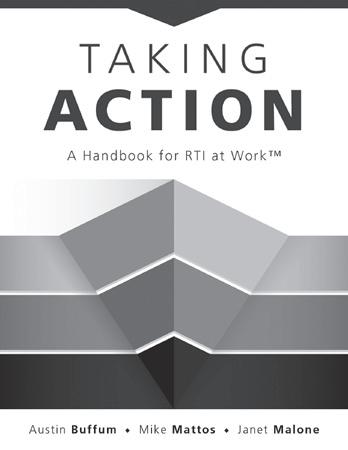

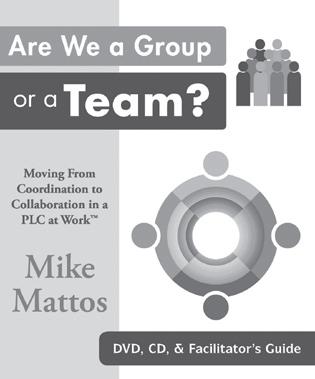
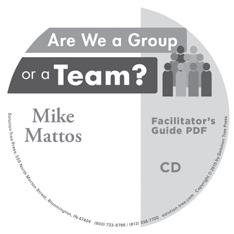

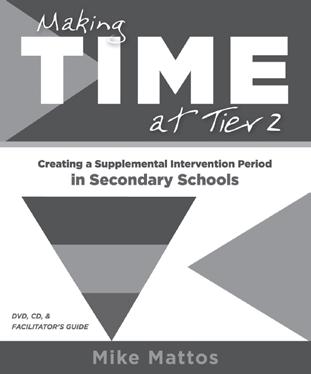


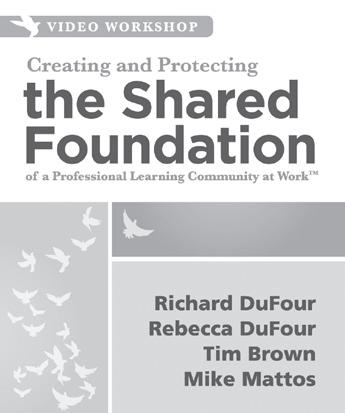
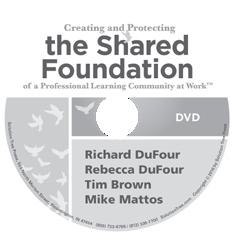
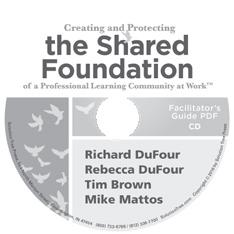
Taking Action
Austin Buffum, Mike Mattos, and Janet Malone
This comprehensive implementation guide covers every element required to build a successful RTI at Work™ program in schools. The authors share step-by-step actions for implementing the essential elements, the tools needed to support implementation, and tips for engaging and supporting educators.
BKF684
Timebomb
Mike Mattos
Timebomb addresses the urgency of reducing dropout rates and preparing students for a better future. Ideal for team meetings and whole-school professional development, the video’s bold message will inspire and energize you and your team to provide the best education possible by collaborating at high levels and establishing quality systems of support.
DVF074
Are We a Group or a Team?
Mike Mattos
Build a powerful PLC to meet the needs of every student. Based on Mike Mattos’s 1-5-10 team-evaluation activity, this unscripted video will give your team the knowhow to transition from a low- to high-performing team. Explore the three foundational elements to build strong teams: forming the right teams that share learning outcomes, providing dedicated time to collaborate, and collaborating professionally.
DVF065
Making Time at Tier 2
Mike Mattos
Give all students the help and enrichment they need. Take a look inside two schools to discover the innovative ways educators developed systematic interventions programs. Discover practical strategies to build Tier 2 intervention and enrichment periods into the school day, and learn how to work in collaborative teams to create targeted interventions and overcome implementation challenges to ensure all students are successful.
DVF066
Creating and Protecting the Shared Foundation of a Professional Learning Community at Work®
Richard DuFour, Rebecca DuFour, Tim Brown, and Mike Mattos
Using the four pillars—mission, vision, values, and goals—essential to implement and sustain a successful PLC, this video workshop outlines the importance of aligning practices, policies, and procedures with a common, shared foundation. K–12 leaders and administrators can view the video as a standalone or use it with the facilitator guide to create two half-day or one full-day workshop for teams.
DVF071
Visit SolutionTree.com or call 800.733.6786 to order.
We realize improving student learning doesn’t happen overnight. And your school or district shouldn’t be left to puzzle out all the details of this process alone.
No matter where you are on the journey, we’re committed to helping you get to the next stage.
Take advantage of everything from custom workshops to keynote presentations and interactive web and video conferencing. We can even help you develop an action plan tailored to fit your specific needs.

Wait! Y our professional development journey doesn’t have to end with the last pages of this book. Let’s get the conversation started. Call 888.763.9045 today. solution-tree.com SolutionTree.com














